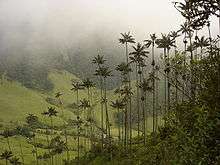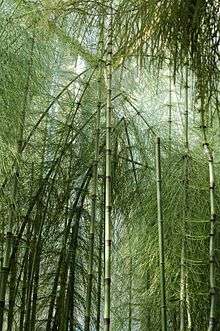List of largest plants
This list lists the largest plants by family.
Conifers (Pinopsida)
- The conifer division of plants include the tallest organism, and the largest single-stemmed plants by wood volume, wood mass, and main stem circumference. The largest by wood volume and mass is the giant sequoia (Sequoiadendron giganteum), native to Sierra Nevada and California; it grows to an average height of 70–85 m (230–279 ft) and 5–7 m (16–23 ft) in diameter.[1] Specimens have been recorded up to 94.9 m (311 ft) in height and (not the same individual) 8.98 m (29.5 ft) in diameter; the largest individual still standing is the General Sherman tree, with a volume of 1,489 m3 (52,600 cu ft).[2]
- Although typically not so large in volume, the closely related coast redwood (Sequoia sempervirens) of the Pacific coast in North America is taller, reaching a maximum height of 115.55 m (379.1 ft) – the Hyperion Tree, which ranks it as the world's tallest known living tree and organism (not including its roots under ground).[3] The largest historical specimen (and largest known single-stem organism) was the Lindsey Creek tree, a coast redwood with a minimum trunk volume of over 2,500 m3 (88,000 cu ft) and a mass of over 3,300 tons. It fell during a storm in 1905.[4]
- The conifers also include the largest tree by circumference in the world, the Montezuma Cypress (Taxodium mucronatum). The thickest recorded tree, found in Mexico, is called Árbol del Tule, with a circumference of 57.9 m (190 ft) at its base and a diameter of 14.5 m (48 ft) at 1.5 m (4.9 ft) above ground level; its height is over 39.4 m (129 ft).[5] These trees dwarf any other non-communal organism, as even the largest blue whales are likely to weigh one-sixteenth as much as a large giant sequoia or coast redwood. See list of superlative trees for other tree records.
Flowering plants (angiosperms)

- This is the most diverse and numerous division of plants, with upwards of 400,000 species.
- Clonal colonies
- For two-dimensional area, the largest known clonal flowering plant, and indeed largest plant and organism, is a grove of male Aspen in Utah, nicknamed Pando (Populus tremuloides). The grove is connected by a single root system, and each stem above the ground is genetically identical. It is estimated to weigh approximately 6,000,000 kg,[6] and covers 0.43 km2 (110 acres).[7][8]
- Another form of flowering plant that rivals Pando as the largest organism on earth in breadth, if not mass, is the giant marine plant, Posidonia oceanica, discovered in the Mediterranean near the Balearic Islands, Spain. Its length is about 8 km (5.0 mi). Although this plant has not been proven to be a single connected organism, all the samples do have the same DNA. It may also be the oldest living organism in the world, with an estimated age of 100,000 years.[9]
- "Individual" plants
Rafflesia arnoldii flower
- By a stricter definition of individuality, and using contending measures of size, Ficus benghalensis, the giant banyan trees of India are the largest trees in the world.[10] In these trees, a network of interconnected stems and branches has grown entirely by vegetative, "branching" propagation. One individual, Thimmamma Marrimanu, in Andhra Pradesh, covers 19,107 square metres, making it the largest single tree by two-dimensional canopy coverage area. This tree is also the world's largest known tree by a related measure, perimeter length, with a distance of 846 metres required to walk around the edge of the canopy. Thimmama Marrimanu is likely also the world's largest tree by three-dimensional canopy volume.
- The tallest flowering plant species known is Eucalyptus regnans, of which a living specimen has been measured at 99.6 m (327 ft) in Southern Tasmania.[11] The longest vine to be accurately measured is "Rattan Manau" (Calamus manan) of the palm family (historically Palmae, but now often Arecaceae) and native to the Malay Peninsula, Sumatra and Java. One unbranched stem at Buitenzorg (now Bogor) Botanic Garden, Java was carefully measured to a length of 787 feet (240 meters).[12]
- Bamboos are a tribe of flowering perennial evergreen plants in the grass family Poaceae, subfamily Bambusoideae, tribe Bambuseae. Dendrocalamus is a tropical genus of giant clumping bamboo found throughout Southeast Asia. It includes Dendrocalamus giganteus, which can reach heights up to 30 m.[13]
- Other records among flowering plants include, the title of largest flower, which belongs to the species Rafflesia arnoldii. One of these flowers can reach a diameter of 1 m (3.3 ft) and weigh up to 11 kg (24 lb).[14] The largest unbranched inflorescence, resembling (but not qualifying as) a giant flower, belongs to the titan arum (Amorphophallus titanum), reaching almost 3 m (9.8 ft) in height.[15] The absolute largest inflorescence, at up to 8 m (26 ft) long, is borne by the talipot palm (Corypha umbraculifera) of India.[16]
Cycads (Cycadophyta)
- The largest species of cycad is Hope's Cycad (Lepidozamia hopei), endemic to the Australian state of Queensland. The largest examples of this species have been over 15 m (49 ft) tall and have had a circumference of 1.5 m (4.9 ft).[17]
Pteridophyta

A stand of Equisetum myriochaetum, the world's largest horsetail species
- Horsetails (Equisetopsida)
- The largest of horsetail is the species Equisetum myriochaetum, native to Nicaragua, Costa Rica, Colombia, Venezuela, Ecuador, Peru and Mexico. The biggest specimen known was 8 m (26 ft) tall and had a diameter of 2.5 cm (0.98 in).[18]
- Ferns (Pteridopsida)
- The largest species of fern is probably Cyathea brownii of Norfolk Island, which may be 20 m (66 ft) or more in height.[19]
Liverworts (Marchantiophyta)
- The largest species of liverwort is a New Zealand species, Schistochila appendiculata. The top size of this species is 1.1 m (3.6 ft) long, a diameter of 2.5 cm (0.98 in) and a stem length of 10 cm (3.9 in).[20]
Mosses (Moss|Bryophyta)
- The world's most massive moss is Dawsonia superba, of New Zealand. This species can be 50 cm (20 in) tall.[21] The tallest moss is Spiridens reinwardti of the family Spiridentaceae and native to Indonesia, Malaysia, Papua New Guinea, the Philippines, Melanesia and Taiwan. S. reinwardti is a vine which is typically 30 to 40 centimeters (12 to 16 inches)high but can climb to a height of 3 meters (9.8 feet) [22] Spiridens reinwardti is the only true vine among mosses and climbs by twining. The longest individuals seem to be in New Guinea.
References
- ↑ Flint, W.D. (2002). To Find The Biggest Tree. Sequoia Natural History Association, ISBN 1-878441-09-4.
- ↑ Gymnosperm Database: Sequoiadendron giganteum. Conifers.org.
- ↑ Kenneth L. Fisher. Redwood, Sequoia sempervirens. humboldt.edu
- ↑ Superlative trees. zilkha.com
- ↑ Zsolt Debreczy and Istvan Racz. El Arbol del Tule: The Ancient Giant of Oaxaca. arboretum.harvard.edu
- ↑ largest living thing. Ontariosciencecentre.ca.
- ↑ Consensus Document on the Biology of Populus, Organisation for Economic Co-operation and Development (.doc file)
- ↑ Quaking Aspen by the Bryce Canyon National Park Service
- ↑ Ibiza's Monster Marine Plant. Ibiza Spotlight (2006-05-28).
- ↑ Bar-Ness, Y.D. (March 2012). "Giant Banyans". GEO International. Retrieved 22 June 2012.
- ↑ "Tasmania's Ten Tallest Giants". Tasmanian Giant Trees Consultative Committee. Archived from the original on 2008-07-18.
- ↑ Paul W. Richards "Tropical Rain Forest" (Cambridge Univ. Press, 1952 edit.) p. 102 Quoting: M. Treub, in "Annales des Jardin Botanique Buitenzorg" (1883) p. 175. ,
- ↑ Bamboos Of India, . Accessed 8 June 2007
- ↑ Rafflesia arnoldii in bloom. Photographed in West Sumatra, Indonesia. Lostworldarts.com
- ↑ Titan Arum: The Largest Tropical Flower on Earth. Environmentalgraffiti.com
- ↑ Dominica Botanic Gardens. Da-academy.org
- ↑ Hope's Cycad. nationalregisterofbigtrees.com.au
- ↑ Equisetum myriochaetum. Natural History Museum. Nhm.ac.uk
- ↑ Braggins, John E. & Large, Mark F. 2004. Tree Ferns. Timber Press, ISBN 0-88192-630-2
- ↑ Folded leaves (Schistochilaceae). Faculty of Science – The University of Auckland
- ↑ Mosses: Native mosses. sbs.auckland.ac.nz
- ↑ Thomas Hallingback and Nick Hodgetts, "Mosses, Liverworts and Hornworts" introduction p. 1 at: http://data.iucn.org/dbtw-wpd/docs/2000-074.pdf (Photograph with human figure and accompanying text).
This article is issued from Wikipedia - version of the 10/18/2016. The text is available under the Creative Commons Attribution/Share Alike but additional terms may apply for the media files.